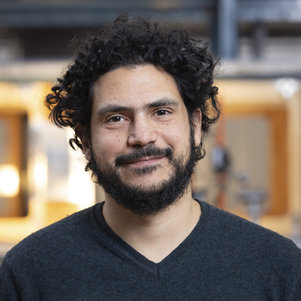NWO Vici grants for Guido de Croon and Marios Kotsonis)
The Netherlands Organisation for Scientific Research (NWO) has awarded Vici funding of up to 1.5 million euros to three Delft scientists. Two of them are colleagues from the Faculty of Aerospace Engineering: Prof Guido de Croon and Prof Marios Kotsonis. This will allow them to develop an innovative line of research and expand their own research group for five years.

Neuromorphic Artificial Intelligence for autonomous robots
Prof.Dr. Guido de Croon, Full Professor Bio-inspired Micro Air Vehicles
Autonomous robots promise to transform our economy and society, thanks to the quick progress in artificial intelligence. However, state-of-the-art AI needs a lot of computational effort, which leads to extra robot weight, costs, and energy consumption. This makes robots with AI large, heavy and dangerous, and hence unsuitable for many applications.
The aim of this project is to create an orders-of-magnitude faster and more energy efficient robotic AI. To reach this goal Guido de Croon and his team will tackle the daunting challenge of developing a neuromorphic AI that gives full autonomy to small robots. De Croon: “This intelligence will be based on neural networks that come closer to the real neurons in the brains of animals. The neurons have a more complex dynamics and asynchronously send pulses to communicate with each other - something that leads to much less energy consumption and much faster information processing.” To best demonstrate this technology’s efficiency, the AI will be modelled after insect intelligence and instilled on a resource-restricted drone. This will unlock innumerable new applications and even provides opportunities to learn about nature itself.
Together with partners from the industry De Croon and his team will also work on the application of this technology, focussing on small autonomous drones performing various tasks in greenhouses, such as monitoring crop and chasing pests. Having autonomous drones performing such tasks will save on resources and reduce the use of pesticides. Success in this challenging application will set the stage for using the developed efficient AI also for other types of robots and applications.
The project is funded with 1,5 million euros. Additionally, industrial partners provide in-kind support amounting to 100.000 euros. The industrial partners involved are: IMEC, PATS, Royal Brinkman, KeyGene, Wageningen University & Research, XOSight, and Opteran.
The NWO VICI is a fantastic opportunity for me to do curiosity-driven research into an extremely efficient form of artificial intelligence for robots. For my work, I take inspiration from the intelligence of insects. I hope my tiny flying robots will soon be able to navigate easily over distances of several kilometres just like honeybees do.
Guido de Croon

Running up that hill: reducing the aerodynamic drag of aircraft
Prof. Marios Kotsonis - Flow Control
Reducing the aerodynamic drag of aircraft can play a key role in reducing emissions. The transition of air flow from a (smooth) laminar state to a turbulent state over the aircraft wing is a major contributor of aerodynamic drag. Often, the transition from laminar to turbulent occurs due to certain modifications of the wing surface, such as panel joints or skin deformations. Professor of Flow Control Marios Kotsonis and his team have recently made a surprising and counterintuitive discovery: when air flow is running up a smooth small ‘hill’ on the aircraft wing, which they’ve since called the Delft Laminar Hump, it remains laminar for much longer, thus making the wing very efficient. This novel finding can revolutionise laminar wings, potentially saving millions of tons of fuel and harmful emissions every year.
However, how the Delft Laminar Hump, does this is currently unclear. Marios Kotsonis: “We simply lack a clear physical understanding of the interaction between laminar-turbulent transition and surface modifications.” In the project, called ‘Running up that hill’, the physics of transitional flows interacting with Hump-like wing surface modifications will be explored and described using a combination of advanced numerical, experimental and theoretical methods. The support and in-kind contributions from leading aerospace partners will help to demonstrate laminar flow at commercial flight conditions using Hump- like modifications.
The project is funded with 1.5 million euros for the coming 5 years. An additional 130k euros is contributed as in-kind funding by industrial partners such as KLM, DNW and Deharde.
This Vici grant comes at a perfect time to answer a long-standing question in flow physics, namely how surface modifications interact, accelerate, and delay transition. The fundamental and technical outcomes of this work will establish Hump-like surface modifications as a realisable method for curbing environmental emissions of aviation. I am very honoured to receive the Vici grant and am excited to start the work!
Marios Kotsonis
Vici grants
Together with the Veni and Vidi grants, Vici funding is part of the NWO Talent Programme. Vici is aimed at senior researchers who have demonstrated their ability to successfully develop their own innovative line of research. In doing so, they have mentored young researchers. Researchers awarded a Vici grant further develop their research group, often in anticipation of a structural professorship position, if they would not already have one.

